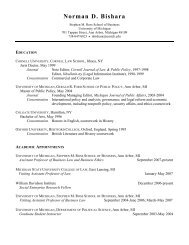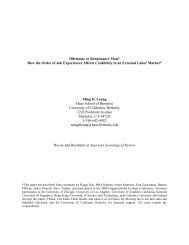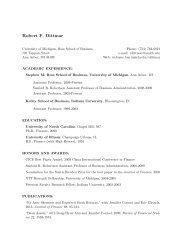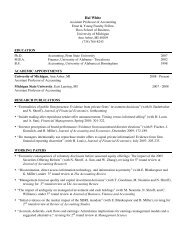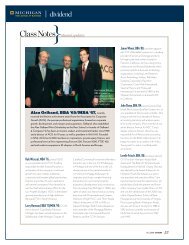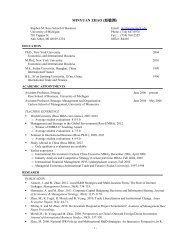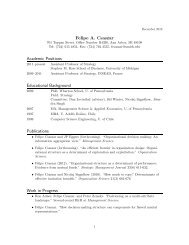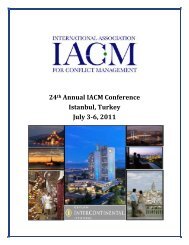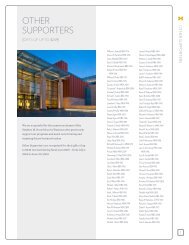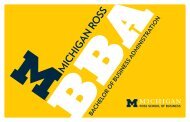DIvIDEnD - Stephen M. Ross School of Business - University of ...
DIvIDEnD - Stephen M. Ross School of Business - University of ...
DIvIDEnD - Stephen M. Ross School of Business - University of ...
Create successful ePaper yourself
Turn your PDF publications into a flip-book with our unique Google optimized e-Paper software.
photo by samuel stuart<br />
a:<br />
Innovation <strong>of</strong>ten is born <strong>of</strong> a pie-in-the-sky<br />
dream to change the world. For Jonathan Koch,<br />
MBA/MS ’96, it’s all about “putting iron in the<br />
ground.” Koch is co-founder and managing<br />
director <strong>of</strong> u.S. Renewables Group (uSRG), one<br />
<strong>of</strong> the largest private equity funds focused solely on<br />
the renewable energy industry. Founded in 2003, the<br />
fund has mobilized more than $750 million <strong>of</strong> capital<br />
commitments via three funds to invest in the renewable<br />
power, bi<strong>of</strong>uel, and infrastructure sectors.<br />
But what usRg really invests in is capacity. “if we’re going to<br />
meet the projected market demand and mandated requirements<br />
for renewable power and fuel in the near future, we have to build<br />
a lot <strong>of</strong> plants,” koch says. “we believe there are several technologies<br />
ready to be deployed. the game is to find qualified developers<br />
and finance the build-out <strong>of</strong> this new expansion.”<br />
usRg’s niche is to create platform companies with the intent<br />
to stamp out fleets <strong>of</strong> large-scale commercial facilities. the firm<br />
looks to make investments between $15-100 million depending on<br />
the stage <strong>of</strong> the project and company lifecycle. “it’s a very different<br />
asset class — with different financial structures and different<br />
returns — than making a venture bet on an unproven technology<br />
or unproven markets,” koch says. “we have to be secure not only<br />
in the core science or process, but also in the fact that this plant<br />
can function as designed at a large scale.”<br />
as a project finance expert at usRg, koch seeks to identify<br />
opportunities in renewable energy and then package a series <strong>of</strong><br />
scalable assets to take to market. this requires everything from<br />
licensing technology and inking permits to negotiating feedstock,<br />
<strong>of</strong>ftake, and power purchase agreements. usRg executes contracts<br />
for engineering, procurement, construction, operations,<br />
and management <strong>of</strong> future plants.<br />
“these are very complex operations, and we are involved in<br />
every step,” koch says. usRg generally takes a controlling position<br />
and active management role in the companies it finances;<br />
koch sits on three boards across multiple sectors. usRg’s funds<br />
are long-lived, and its hold time can last anywhere from three to<br />
six years.<br />
HERE coMES THE SUn one example is solarReserve, which<br />
solves several issues in the solar energy space, according to koch.<br />
notably, it relies on technology developed by the fortune 50<br />
firm united technologies corp. (utc) that allows for large-scale<br />
underground storage <strong>of</strong> dispatchable thermal energy. Plants are<br />
designed at 250 megawatts or more and rely on low-water-use<br />
technology. koch calls solarReserve a “tremendous win,” especially<br />
because utc is backing the technology with performance<br />
guarantees and is helping to build the component parts.<br />
usRg purchased a worldwide license for the technology from<br />
utc. then it recruited engineers and scientists from Rocketdyne<br />
Propulsion & Power (who created the technology) and veteran<br />
managers with expertise in the power industry. solarReserve now is<br />
developing multiple plants in the western u.s. and around the world.<br />
usRg also has invested in developing the first commercial-scale<br />
facility for fulcrum Bioenergy, which would convert the organic<br />
components in municipal solid waste into cellulosic ethanol, considered<br />
an advanced bi<strong>of</strong>uel by the environmental Protection<br />
agency. Permits are in place to build its first plant in Reno, nev.<br />
usRg projects it would produce 10 million gallons <strong>of</strong> fuel per year.<br />
FUElinG innoVATion But first things first. solarReserve and<br />
fulcrum Bioenergy, two <strong>of</strong> 12 active companies at usRg, now are<br />
transitioning from development to debt financing. they face a<br />
tight credit market, ever-changing regulatory policy, tax issues,<br />
and other unknowns. “that means we have to bring to market the<br />
most compelling projects possible,” koch says.<br />
the market where finance and renewable energy meet is a point<br />
that has attracted koch throughout his career. today he combines<br />
institutional experience he gained at ge and Booz allen with<br />
entrepreneurial expertise from his stint as coo <strong>of</strong> a portfolio<br />
company <strong>of</strong> kleiner, Perkins, caufield & Byers. he also was the<br />
co-founder and ceo <strong>of</strong> sundial, a leader in provisioning utility<br />
services online.<br />
“my career had been focused on improving large, industrial systems;<br />
i learned how the multinationals produce and manage the<br />
environmental impacts <strong>of</strong> fuel, chemicals, and power,” koch says.<br />
“then, along with my partners at usRg, we saw this great opportunity<br />
to take tried-and-true financial skills and tried-and-true<br />
renewable energy technology and start building capacity.”<br />
where it gets really interesting is identifying those technologies<br />
poised to become full-scale commercial. “it’s what the venture<br />
firms are struggling with because they now have a pilot plant but<br />
need someone to finance commercial-scale units,” he says. “a lot<br />
<strong>of</strong> people refer to this as the valley <strong>of</strong> death.”<br />
usRg is one <strong>of</strong> the investors that can help companies throughout<br />
the development process to cross that valley <strong>of</strong> death. “we’re<br />
excited about creating terrific new companies we think can<br />
change the world,” says koch. “if we can effect real change in how<br />
we produce kilowatts and gallons <strong>of</strong> fuel, we can reduce our carbon<br />
footprint. and we can create a more sustainable economy.”<br />
—Deborah Holdship<br />
spring 2010 <strong>DIvIDEnD</strong> 39



